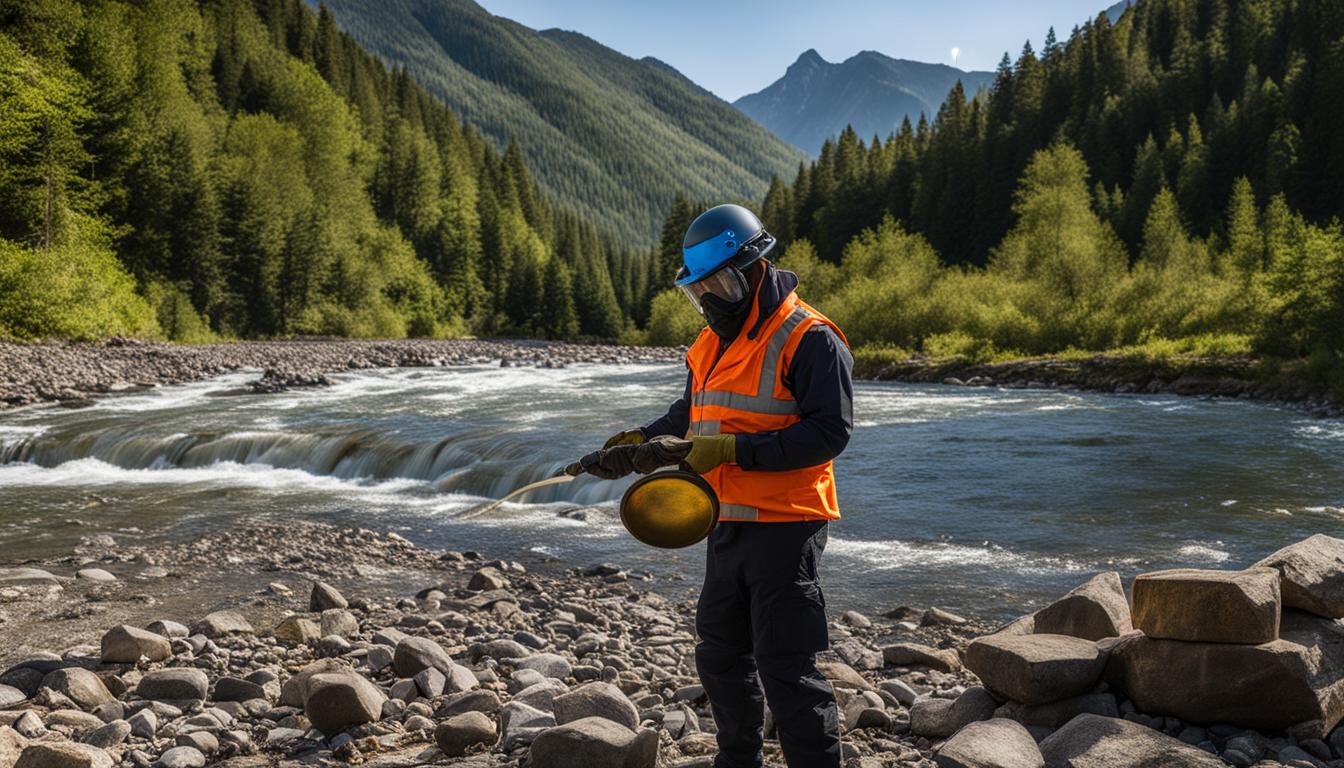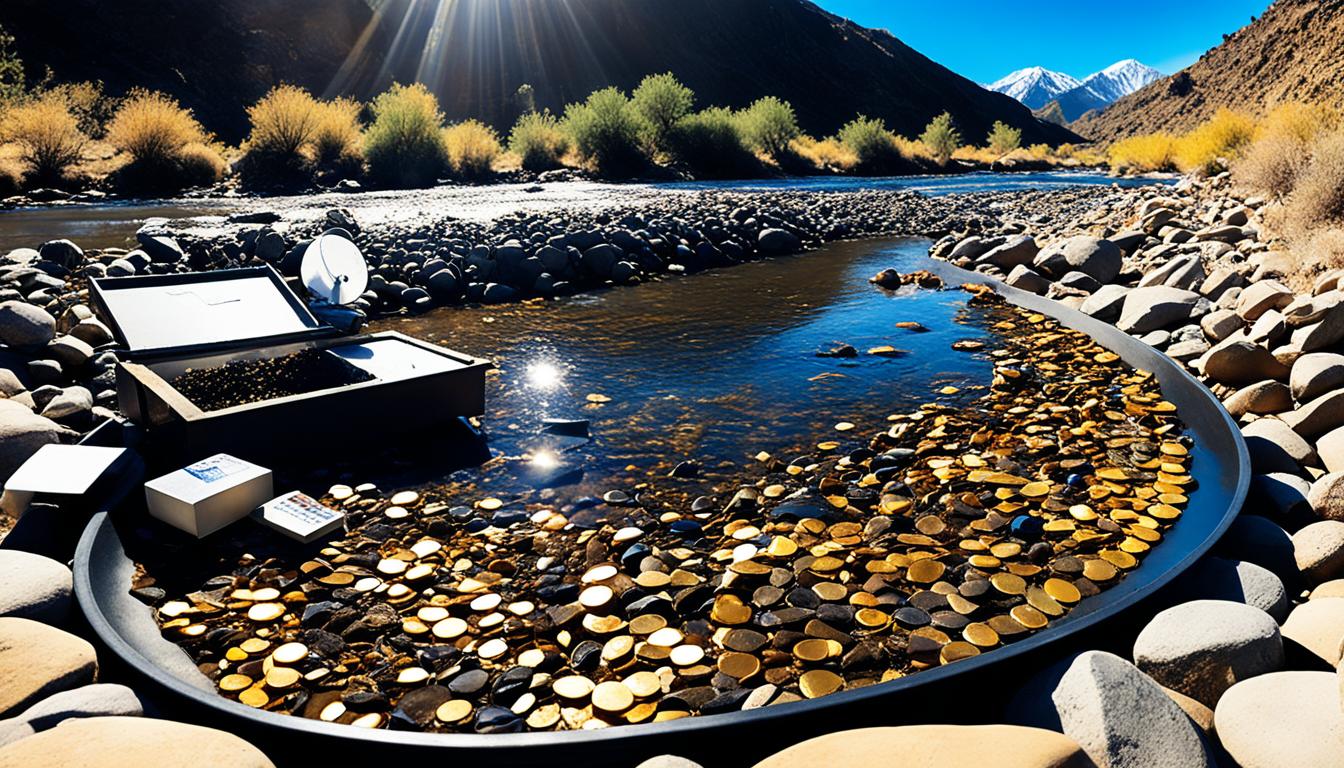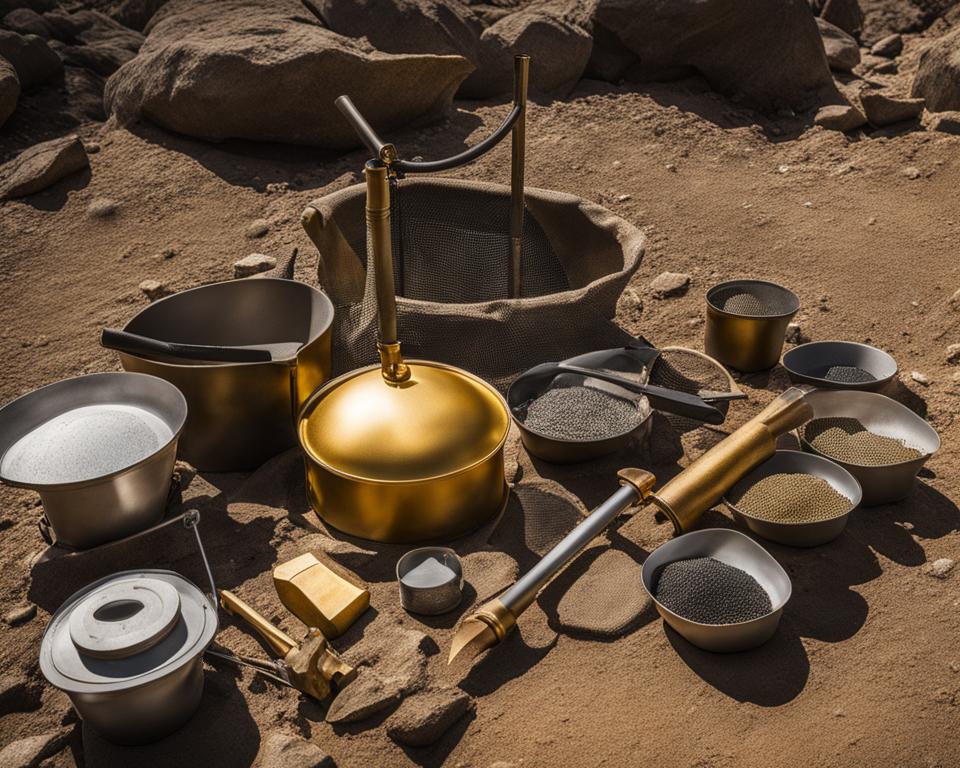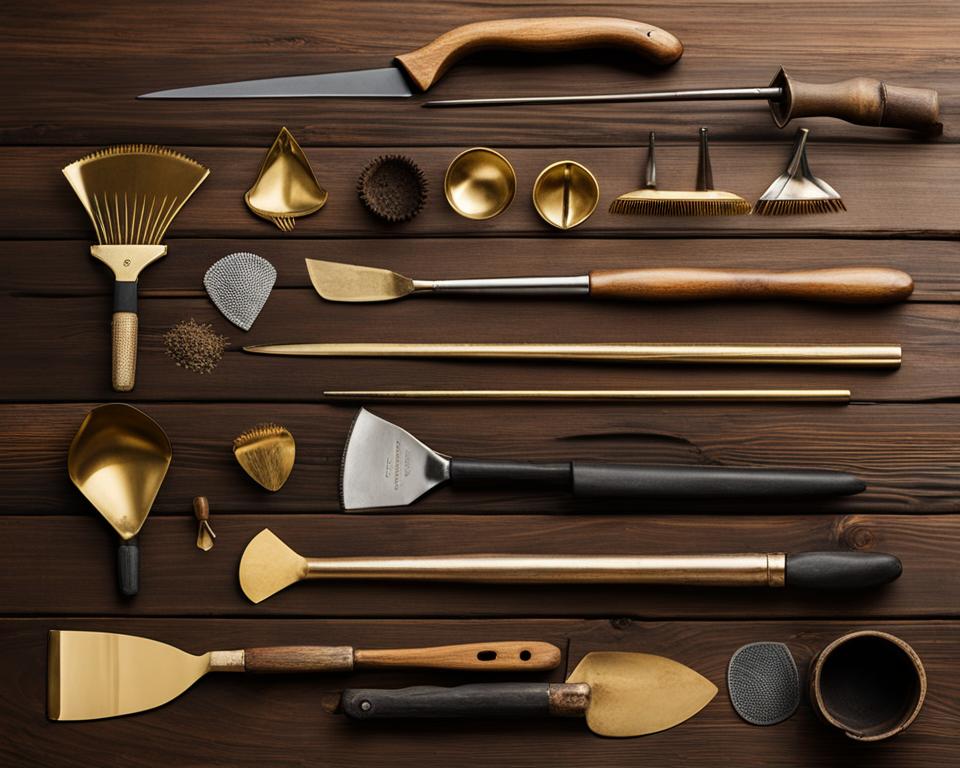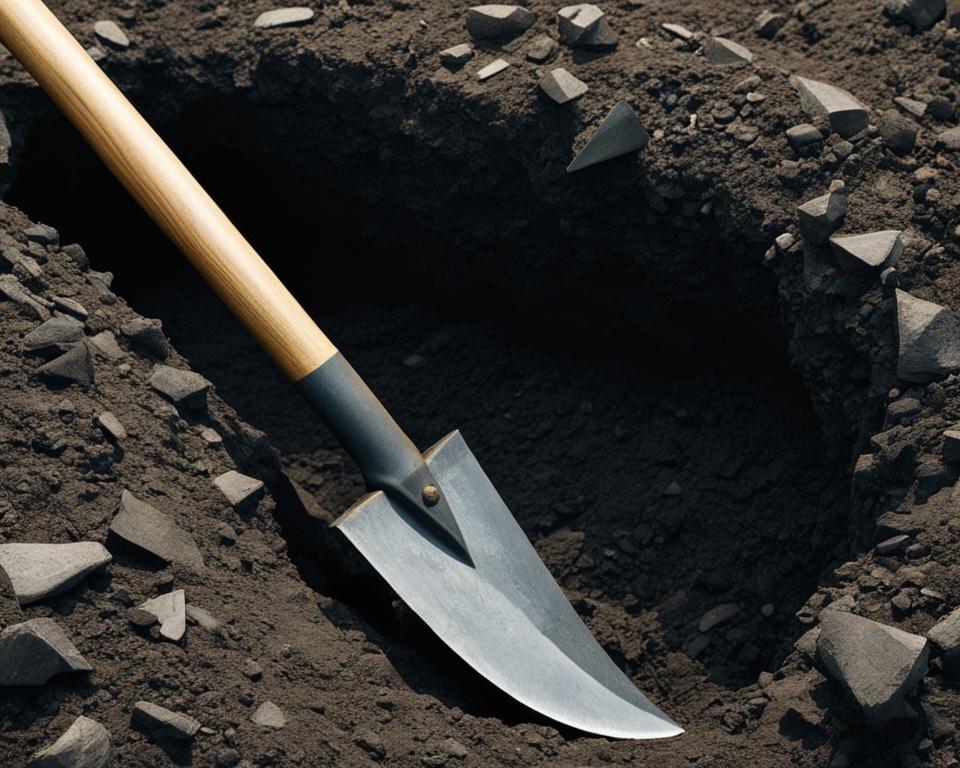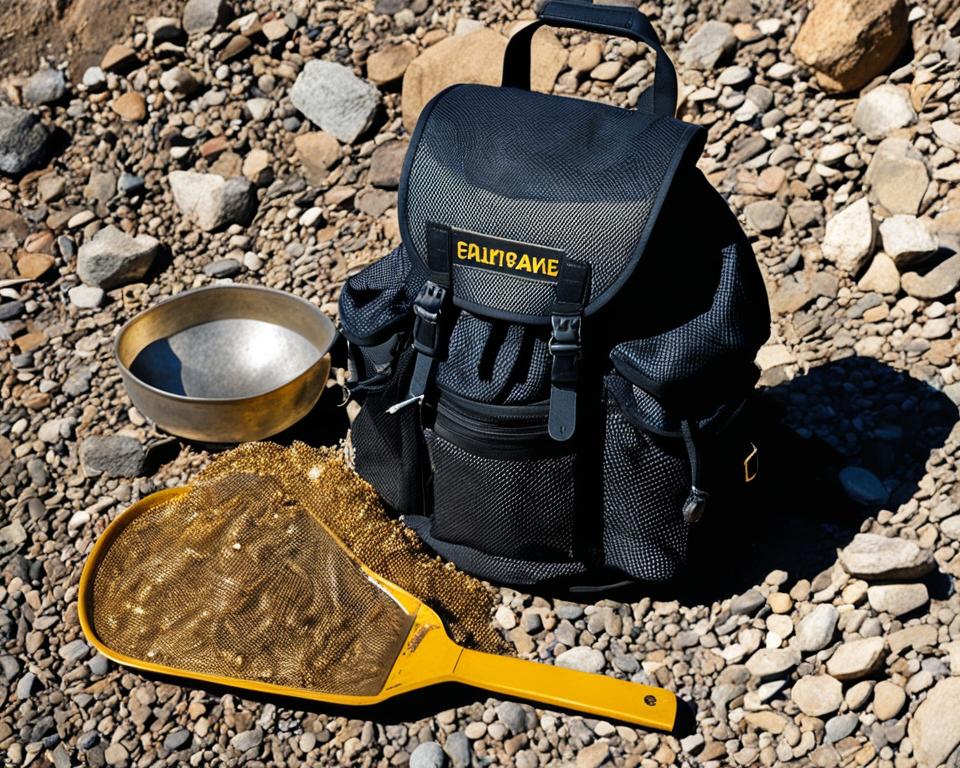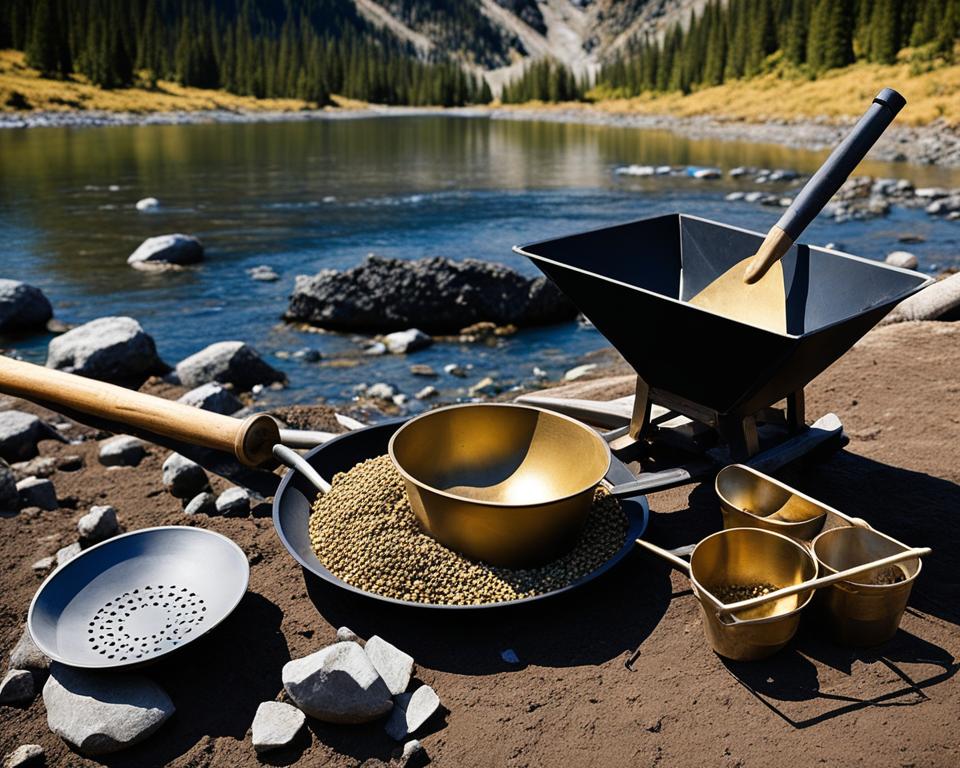
Gold panning is an exciting outdoor activity that requires the right tools and equipment for a successful prospecting experience. In this article, we will explore the best tools available for gold panning, including gold pans, shovels, sluices, and more. Whether you are a beginner or an experienced prospector, having the right tools can greatly enhance your chances of finding gold and optimizing your prospecting game.
Key Takeaways:
- Choosing the best tools for gold panning is essential for successful prospecting.
- Must-have gold panning gear includes gold pans, shovels, and sluices.
- High-quality gold panning supplies can enhance your chances of finding gold.
- Recommended gold panning equipment varies based on skill level and budget.
- Investing in reliable gold panning gear can optimize your prospecting experience.
Equipment you need for gold panning
To get started with gold panning, there are a few essential tools that you will need. These include a gold pan, a shovel, and some basic equipment. The gold pan is the most basic and important tool for gold panning, as it allows you to separate the gold from the sand and gravel. A reliable gold pan, such as the Garrett Super Sluice or the Proline Blue 14 in, is recommended for beginners. A sturdy shovel, like the Fiskars #2 Spade, is essential for digging and moving the material. Additionally, some basic equipment such as crevicing tools and a river sluice can be helpful in more advanced prospecting.
Gold Pans
| Recommended Gold Pans | Specifications |
|---|---|
| Garrett Super Sluice | Material: Plastic Size: 15″ Diameter Features: Dual Riffles for Effective Separation |
| Proline Blue 14 in | Material: Steel Size: 14″ Diameter Features: Deep Riffles for Efficient Gold Retention |
Shovels
| Sturdy Shovels | Specifications |
|---|---|
| Fiskars #2 Spade | Material: Steel Blade Size: 44″ Length Features: Durable and Ergonomic Design |
Basic Equipment
- Crevicing Tools: These specialized tools, including a geologist’s hammer and a crevice tool, are used for extracting gold from cracks and crevices in rocks.
- River Sluice: A river sluice, like the Keene A52 River Sluice, can be used to process larger amounts of material and increase your chances of finding gold.
Now that you know the essential equipment needed for gold panning, you can confidently embark on your prospecting adventure. Remember to choose reliable tools that suit your skill level and budget. Happy panning!
What to Wear Gold Panning
When heading out for a day of gold panning, it is important to wear the right gear to protect yourself and stay comfortable. Here are three essential items to consider:
- Rubber Boots: Keep your feet dry while working in the water by wearing rubber boots. These boots provide excellent traction and help prevent water from seeping in. Waterproof boots from trusted brands like Muck Boot Company and Bogs are highly recommended. They come in various styles and sizes to suit your preferences.
- Gloves: Protect your hands and improve your grip on the gold pan with rubber dishwashing gloves. These gloves are durable, waterproof, and provide a secure grip when handling rocks and gravel. Look for gloves with textured surfaces for extra grip, such as the Atlas 620 Vinylove gloves.
- Sun Hat: Shield yourself from the sun’s rays and stay cool during your gold panning adventures by wearing a sun hat. A wide-brimmed hat, like the Columbia Bora Bora Booney II Sun Hat, offers excellent sun protection for your face, neck, and ears. It also helps provide some shade while you are out prospecting.
Stay Protected and Comfortable
By wearing rubber boots, gloves, and a sun hat, you can ensure a more enjoyable gold panning experience. Not only will you stay dry and protected from the elements, but you’ll also have better grip and increased comfort throughout your prospecting journey.
Equipment for Desert Gold Panning
When it comes to gold panning in desert environments, specialized equipment is essential for optimal results. The dry conditions call for tools designed specifically to handle the unique challenges of extracting gold from dry desert soil. Two key tools that can greatly enhance your desert gold panning experience are a drywasher and a metal detector.
1. Drywasher
A drywasher is a popular piece of equipment for extracting gold from desert soil. It utilizes air and vibration to separate the lighter materials, such as sand and gravel, from the heavier gold particles. One highly regarded drywasher option is the Keene 140, known for its efficiency and reliability in dry desert conditions.
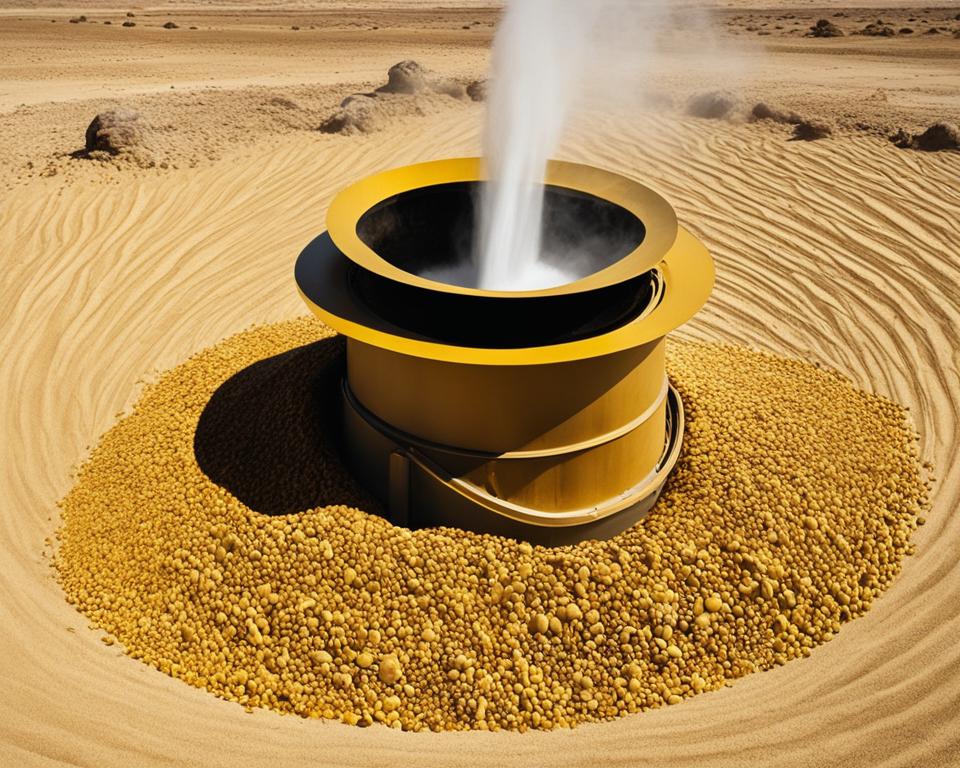
2. Metal Detector
While gold nuggets may be hidden in the desert landscape, a metal detector can be a valuable tool for locating them. Metal detectors emit electromagnetic waves that can identify metallic objects, including gold nuggets. The MineLab Equinox 800 and the MineLab Gold Monster 1000 are popular metal detectors known for their sensitivity and ability to detect gold in the desert.
By combining the power of a drywasher and a metal detector, you can significantly increase your chances of finding gold in arid desert regions. Whether you’re prospecting in the Mojave Desert or exploring the Sonoran Desert, these tools will prove invaluable in maximizing your desert gold panning success.
Intermediate Level Gold Panning Equipment
As you progress in your gold panning skills, you may want to invest in some intermediate level equipment. These tools can help you take your prospecting game to the next level. Two essential pieces of equipment for intermediate gold panning are crevicing tools and a river sluice.
Crevicing Tools
Crevicing tools are designed specifically to extract gold from cracks and crevices in rocks. A popular and effective tool is a geologist’s hammer. This sturdy tool allows you to break apart rocks and access the hidden gold within. With the geologist’s hammer, you can carefully chip away at the rock surfaces to reveal any gold-bearing material.
“The geologist’s hammer is a versatile tool that every serious gold panner should have in their arsenal. It’s perfect for reaching the gold that other tools might miss.”
River Sluice
A river sluice is a valuable piece of equipment that can process larger amounts of material, increasing your chances of finding gold. The Keene A52 River Sluice is a popular choice among intermediate gold panners. This sluice is designed to efficiently capture gold particles as the material flows through the sluice box. The riffles and carpeting inside the sluice trap the gold, allowing you to recover it later. With a river sluice, you can process more material in less time, increasing your overall productivity.
Using a river sluice requires proper setup and positioning to ensure maximum gold recovery. Make sure to adjust the angle and water flow to optimize the sluice’s performance. With practice and experience, you’ll become proficient at using the river sluice to extract gold from your panning material.
“The Keene A52 River Sluice is a reliable and effective tool that can help intermediate gold panners process larger amounts of material. Don’t miss out on the hidden gold waiting to be discovered.”
Advanced Level Gold Panning Equipment
Experienced prospectors understand the value of advanced equipment when it comes to gold panning. These tools can take your prospecting game to the next level, increasing your chances of finding gold. Here are some advanced level options to consider:
Highbanker – The Gold Hog Piglet
The highbanker is a versatile tool that combines the functionality of a sluice and a dredge. The Gold Hog Piglet is a top-rated highbanker that allows you to process larger amounts of material efficiently. It helps separate gold from other sediments, offering a higher recovery rate.
Dredge – Keene 4″ Dredge
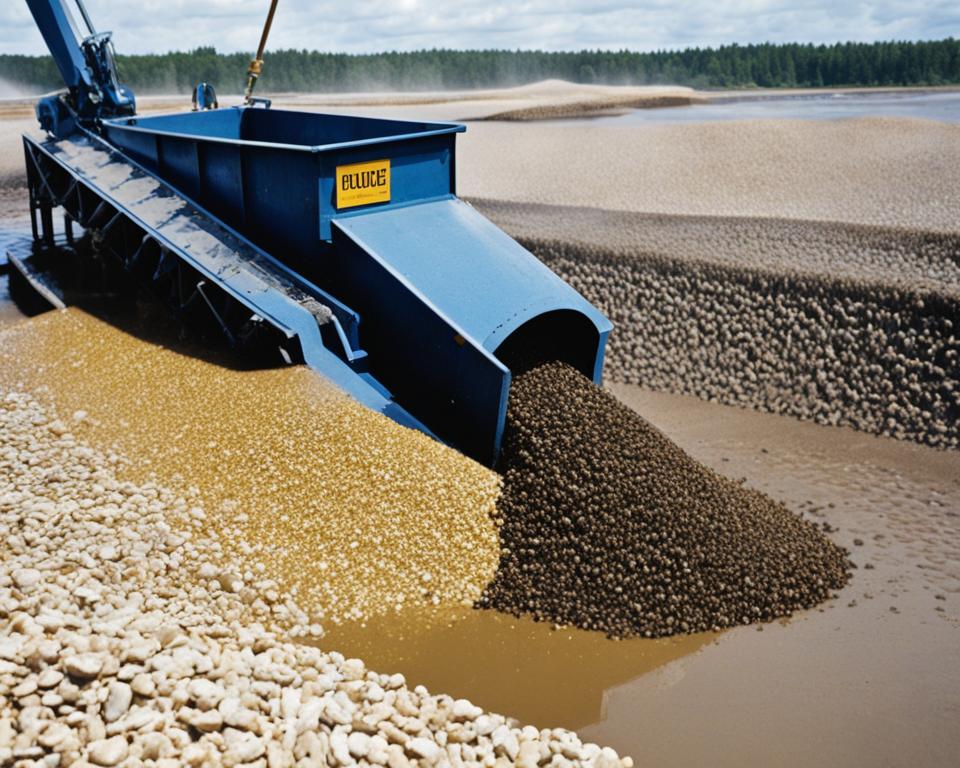
A dredge is an excellent tool for extracting gold from underwater deposits. The Keene 4″ Dredge is a reliable option that allows you to reach areas inaccessible to other equipment. With its powerful suction, it can efficiently extract gold and recover larger quantities during your prospecting ventures.
Mini Wash Plant
A mini wash plant is a compact and portable option for processing larger amounts of material. It enables efficient gold recovery by utilizing water, screens, and riffles to separate gold particles from other sediments. With its portability, you can take it to remote locations and optimize your gold panning operations.
Investing in advanced-level equipment like a highbanker, dredge, or mini wash plant can significantly improve your gold panning results. These tools provide advanced functionality, enhance gold recovery rates, and enable prospecting in various environments. By incorporating them into your prospecting arsenal, you’ll have the advantage of processing larger volumes of material and increasing your chances of finding valuable gold deposits.
Where to Find Gold
Finding gold starts with knowing where to look. Conducting thorough research on historical gold locations can provide valuable insights and increase your chances of striking gold. Here are some ways to uncover potential gold-rich areas:
Local Rock and Gem Shops
Pay a visit to your local rock and gem shops. These establishments often have knowledgeable staff who can offer advice on historical gold locations in the area. They may also have books, maps, or other resources that provide information on gold-bearing regions.
Government Geological Reports
Government geological organizations, such as the US Geological Survey, publish reports that detail historical gold discoveries, mining operations, and geological data. These reports are a valuable source of information for understanding the geology and potential gold deposits in an area. Check their websites and online databases for access to these reports.
Online Resources
Explore online resources dedicated to gold prospecting, such as thediggings.com. These platforms provide searchable databases of gold mine locations and historical gold rushes. You can obtain useful information on specific locations, including production records, gold types, and potential gold-bearing areas.
“Researching historical gold locations can provide valuable insights and increase your chances of striking gold.”
Local Prospecting Clubs
Joining local prospecting clubs can be immensely beneficial for discovering gold locations in your area. These clubs consist of experienced prospectors who possess firsthand knowledge of successful gold panning spots. They often organize group outings, where you can learn from experienced members and gain valuable insights into the best places to find gold.
Historical Gold Rushes and Indigenous Cultural Sites
Historical gold rushes and indigenous cultural sites can be excellent indicators of potential gold-bearing areas. Research local history books, newspapers, and archives to identify regions that experienced significant gold rushes in the past. Additionally, indigenous cultural sites that were historically associated with gold mining activities can offer clues about potential gold-rich locations.
| Resource | Description |
|---|---|
| Local Rock and Gem Shops | Knowledgeable staff and resources on historical gold locations |
| Government Geological Reports | Detailed information on gold discoveries and geological data |
| Online Resources | Searchable databases of gold mine locations and historical gold rushes |
| Local Prospecting Clubs | Access to experienced prospectors and firsthand knowledge |
| Historical Gold Rushes and Indigenous Cultural Sites | Indicators of potential gold-bearing areas |
How to Find Gold on Public Land
Prospecting for gold on public land can be an exciting adventure, but it requires careful research and adherence to regulations. While recreational gold panning is often permitted, it’s crucial to respect any existing mining claims and obtain permission when necessary. By understanding land ownership details and using helpful tools like the OnX app, you can maximize your chances of finding gold. Exploring federal land, such as areas managed by the US Forest Service and Bureau of Land Management, is generally allowed for prospecting purposes. However, it is essential to be aware of any mining claims and follow all rules and regulations in place.
Researching Public Land Access
Before heading out to prospect for gold on public land, it’s crucial to research the accessibility of the specific areas you plan to explore. Understanding the land ownership details and any restrictions in place will help you avoid trespassing and ensure a smooth and legal prospecting experience. The OnX app is a valuable tool that can provide up-to-date information on land ownership, allowing you to plan your prospecting activities accordingly.
Obtaining Permission and Respecting Mining Claims
While recreational gold panning is often allowed on public land, it is important to respect any existing mining claims. In some cases, individuals or organizations may hold exclusive rights to explore or mine specific areas. To avoid conflicts and legal issues, it is advisable to contact the local land management agency or mining claim owner for permission before prospecting in those areas. Respecting these claims ensures the fair and responsible use of public land for all individuals involved in gold prospecting.
Remember, good communication and respect for others’ claims can go a long way in the prospecting community.
Prospecting on Federal Land
Federal land managed by agencies like the US Forest Service and Bureau of Land Management often presents ample opportunities for gold prospecting. These lands are generally open to exploration; however, it is essential to be aware of any specific regulations and restrictions that may apply. For instance, some areas may have seasonal closures or require permits for certain activities. By familiarizing yourself with the rules and regulations governing prospecting on federal land, you can enjoy a fruitful and compliant gold panning experience.
Fool’s Gold vs. Gold: How to recognize real gold
One of the challenges in gold panning is distinguishing real gold from fool’s gold, also known as iron pyrite. Real gold is heavier than any other material in your pan and will be the last thing to move when gently swirling the water. Placer gold is usually more pure and far more colorful than common jewelry alloys. On the other hand, fool’s gold fractures at sharp angles and lacks the weight and color of real gold.
If you’re unsure whether you’ve found real gold or fool’s gold, here are a few key factors to consider:
- Weight: Gold is much heavier than most other materials, so it should feel heavier in your hand compared to similar-sized pieces of fool’s gold.
- Color: Real gold has a distinct yellow or golden color, while fool’s gold often appears brassy or more towards a pale yellow shade.
- Malleability: Gold is a soft metal and can be easily bent and shaped, while fool’s gold is more brittle and prone to fracturing.
To further assist you in identifying real gold, refer to the image below:
“Gold is like a magnet, once you have found it you want more.”
By carefully examining the weight, color, and malleability of a suspected gold specimen, you can increase your confidence in determining whether it is real gold or fool’s gold. Remember, though, that even fool’s gold can be an exciting find and add to the adventure of gold panning!
| Real Gold | Fool’s Gold |
|---|---|
| Heavier than other materials | Lighter than real gold |
| Distinct yellow or golden color | Brassy or pale yellow shade |
| Soft and malleable | Brittle and prone to fracturing |
Refining your technique
Gold panning is a skill that takes practice and refinement. By developing efficient and effective panning techniques, you can greatly improve your gold recovery and increase your chances of finding valuable nuggets. Here are some tips and tricks to enhance your gold panning technique:
- Focus on small movements: When panning for gold, it’s important to pay attention to every detail. Instead of making large, sweeping motions with your pan, try small, controlled movements. This allows you to better observe the material in your pan and spot any potential gold.
- Experiment with angles and motions: Different angles and motions can affect how the materials in your pan separate. Try angling your pan slightly and experiment with circular motions, side-to-side motions, or a combination of both. This can help separate the heavier gold from the lighter sediment.
- Adjust water flow rates: The speed at which water flows into your pan can impact your panning results. Too much water can wash away small gold particles, while too little water can make it difficult to properly separate the materials. Experiment with different water flow rates to find the optimal balance.
Remember, practice makes perfect. Take the time to hone your technique and become familiar with the unique properties of gold and other materials in your pan. Learning from experienced prospectors and watching instructional videos can also provide valuable insights and help you refine your skills.
“The more you practice, the better your gold panning technique becomes. Don’t be discouraged by initial setbacks; instead, use them as learning opportunities to improve and refine your skills.”
Gold Panning Tips and Tricks:
Here are some additional tips and tricks to enhance your gold panning experience:
- Use a classifier: Using a classifier, such as a mesh screen or sieve, can help separate larger rocks and debris from your pan. This allows you to focus on the finer materials that may contain gold.
- Work in layers: When panning in an area, work in layers by gradually reducing the amount of material in your pan. This helps prevent any potential gold from being washed away during the panning process.
- Understand the geology: Learn about the geology of the area you’re prospecting in. Understanding the types of rocks and minerals that typically host gold deposits can give you a better idea of where to concentrate your efforts.
- Document your findings: Keep a log of your gold panning adventures, noting the locations, techniques, and results. This can help you track patterns and refine your strategy over time.
By continuously refining your technique and incorporating these tips and tricks, you’ll become a more skilled and successful gold prospector. So grab your pan, head to the rivers, and start panning for that precious gold!
| Gold Panning Technique | Practice Tips | Tricks to Enhance Your Skills |
|---|---|---|
| Focus on small movements | Experiment with angles and motions | Adjust water flow rates |
| Use a classifier | Work in layers | Understand the geology |
| Document your findings |
Strategies for Finding Gold
Finding gold requires a combination of strategic planning and persistence. By developing effective prospecting strategies, understanding the difference between prospecting and mining, and setting realistic expectations, you can optimize your chances of finding gold while enjoying the excitement of this outdoor activity.
Developing Prospecting Strategies:
When it comes to finding gold, having a well-defined plan is essential. Start by conducting thorough research on gold-bearing areas, taking into account historical records, geological reports, and local knowledge. This information will help you identify potential locations where gold may be found.
Once you have identified these areas, it’s important to devise a systematic approach to your prospecting efforts. This may include targeting specific riverbeds, investigating bedrock cracks, or exploring areas with a history of gold discoveries. By focusing your efforts on areas with the highest likelihood of gold deposits, you can maximize your chances of success.
Additionally, consider joining local prospecting clubs or connecting with experienced prospectors who can provide valuable insights and guidance. Collaborating with others who share the same passion can greatly improve your prospecting strategies and increase your chances of finding gold.
Understanding Prospecting vs. Mining:
It is crucial to understand the difference between prospecting and mining in your gold-seeking journey. Prospecting refers to the exploration phase, where you search for potential gold deposits. It involves activities such as sampling, testing, and assessing the viability of a site for extracting gold.
Mining, on the other hand, involves the extraction of gold from a larger-scale operation. It requires permits, machinery, and a more significant investment of time and resources. While prospecting can be done by individuals or small groups, mining typically involves commercial operations that aim to extract gold on a larger scale.
By grasping the distinction between prospecting and mining, you can focus your efforts on exploring and identifying promising areas before deciding if larger-scale mining operations are viable.
Setting Realistic Expectations:
While gold panning can be an exciting and rewarding activity, it’s crucial to have realistic expectations about finding gold. The amount of gold you find can vary significantly depending on factors such as location, historical mining activity, and geological conditions.
Although gold can be found in many areas, it is important to remember that it is a finite resource and not evenly distributed. Some locations may have higher gold concentrations, while others may have lower or even no gold deposits.
Set reasonable expectations for your gold panning adventures and keep in mind that finding gold is not guaranteed. Approach gold panning as an enjoyable outdoor activity that allows you to connect with nature and explore new places, with the added excitement of discovering a precious metal along the way.
“Gold prospecting is like a treasure hunt, with each exploration offering its own unique experience. Enjoy the journey and the thrill of the hunt, and remember that even if you don’t find gold, you are still gaining valuable knowledge and memories.”
So, get out there, plan your prospecting strategies, have a clear understanding of prospecting vs. mining, and embrace the excitement of finding gold in nature. While the outcome may not always be gold, the experience and adventure are sure to leave lasting memories.
Conclusion
Investing in the best tools for gold panning is essential to optimize your prospecting game and increase your chances of finding gold. Whether you are a beginner or an experienced prospector, having the right equipment can make a significant difference in your success.
Start with the basics, such as high-quality gold pans and sturdy shovels, to ensure you have the necessary tools for separating gold from sand and gravel. As you progress, consider upgrading to more advanced equipment like highbankers and dredges, which can increase your gold recovery and processing capabilities.
But remember, it’s not just about the tools. Researching gold-bearing areas, practicing your technique, and managing your expectations are equally important in optimizing your prospecting experience. Keep in mind that finding gold is not guaranteed, but with the right tools, knowledge, and determination, you can immerse yourself in the excitement of discovering gold in nature. Happy prospecting!
Source Links
- https://www.treelinereview.com/learn-skills/get-started-gold-prospecting
- https://www.goldfeverprospecting.com/goprsu.html
- https://findinggoldincolorado.com/specific-gold-prospecting-gear-recommendations/

Meet Ryan Conlon, the passionate owner and driving force behind Pan for Treasure.
With an unwavering love for the art of gold panning, Ryan has transformed his enthusiasm into a thriving community hub for fellow treasure seekers. [email protected]
A seasoned gold panning enthusiast, Ryan’s journey began with a simple pan and a dream, evolving into a deep appreciation for the history, geology, and thrill of uncovering precious metals.


